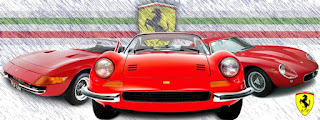 The
company’s story officially began in 1947 when the first Ferrari
emerged from the historic factory entrance on Via Abetone Inferiore
in Maranello. The 125 S, as it was known, embodied the passion and
determination of the company’s founder.
The
company’s story officially began in 1947 when the first Ferrari
emerged from the historic factory entrance on Via Abetone Inferiore
in Maranello. The 125 S, as it was known, embodied the passion and
determination of the company’s founder.
Enzo
Ferrari was born in Modena on February 18th 1898 and died on August
14th 1988. He devoted his entire life to designing and building
sports cars and, of course, to the track. Having been made an
official Alfa Romeo driver in 1924, within five years he had gone on
to found the Scuderia Ferrari on Viale Trento Trieste in Modena which
assisted mostly gentlemen drivers in racing their cars.
In
1938, Enzo Ferrari was appointed head of Alfa Corse but quit the
position in 1939 to set up his own company, Auto Avio Costruzioni,
which operated out of the old Scuderia buildings.
This
new company produced the 1,500 cm³ 8-cylinder 815 spider, two of
which were built for the Mille Miglia in 1940.
 All
racing activities ground to a halt, however, with the outbreak of the
Second World War and, in late 1943, Auto Avio Costruzioni moved from
Modena to Maranello. The end of the war saw Ferrari design and build
the 1,500 cm³ 12-cylinder 125 S, which made its competitive debut in
the hands of Franco Cortese at the Piacenza Circuit on May 11th 1947.
All
racing activities ground to a halt, however, with the outbreak of the
Second World War and, in late 1943, Auto Avio Costruzioni moved from
Modena to Maranello. The end of the war saw Ferrari design and build
the 1,500 cm³ 12-cylinder 125 S, which made its competitive debut in
the hands of Franco Cortese at the Piacenza Circuit on May 11th 1947.
On
the 25th of the same month, it won the Rome Grand Prix at the city’s
Terme di Caracalla Circuit. Since that fateful day, Ferrari has
garnered over 5,000 victories on the world’s tracks and roads,
becoming a modern-day legend in the process. In order to meet growing
market demand, Enzo Ferrari sold the Fiat Group a 50% stake in the
company in 1969, a figure that rose to 90% in 1988.
 Ferrari’s
share capital is currently divided as follows: 90% Fiat Group, 10%
Piero Ferrari. After the founder passed away in the late 1980s, the
shareholders decided to relaunch the struggling company, appointing
Luca di Montezemolo as Chairman in 1991.
Ferrari’s
share capital is currently divided as follows: 90% Fiat Group, 10%
Piero Ferrari. After the founder passed away in the late 1980s, the
shareholders decided to relaunch the struggling company, appointing
Luca di Montezemolo as Chairman in 1991.
Under
the latter’s guidance, Ferrari returned to predominance in Formula
1, launched a string of new models and opened up new markets whilst
still retaining the core values from its past. Ferrari also embarked
upon Formula Uomo, a major renovation programme that puts employees
firmly at the centre of company life by creating a bright, safe,
innovative and eco-friendly working environment.
 Up
to now Ferrari’s list of racing plaudits read as follows: 15 F1
Drivers’ World titles, 16 F1 Constructors’ World titles, 14
Sports Car Manufacturers’ World titles, 9 victories in the Le Mans
24 Hours, 8 in the Mille Miglia, 7 in the Targa Florio, and 216 in F1
grands prix.
Up
to now Ferrari’s list of racing plaudits read as follows: 15 F1
Drivers’ World titles, 16 F1 Constructors’ World titles, 14
Sports Car Manufacturers’ World titles, 9 victories in the Le Mans
24 Hours, 8 in the Mille Miglia, 7 in the Targa Florio, and 216 in F1
grands prix. The
legendary symbol used by Ferrari has heroic origins. It was first
adopted as a personal emblem by a highly decorated Italian World War
I pilot, Francesco Baracca, who had it painted on the fuselage of his
aircraft.
The
legendary symbol used by Ferrari has heroic origins. It was first
adopted as a personal emblem by a highly decorated Italian World War
I pilot, Francesco Baracca, who had it painted on the fuselage of his
aircraft.
At
the end of the war, Baracca’s parents offered to allow Enzo Ferrari
use the Cavallino Rampante (Prancing Horse) symbol. He adopted it as
the logo for his racing Scuderia, placing it on a yellow shield in
honour of his hometown of Modena and topping it with the Italian
tricolour.
The
classic Ferrari red, however, was simply the colour assigned by the
International Automobile Federation to Italian grand prix cars in the
early years of the last century.











0 comments:
Post a Comment